When we moved into our current house, the front foundation planting consisted of clipped Japanese Yews (Taxus cuspidata). One of the first things I did was cut down the Yews and replace them with a planting of Ostrich Ferns (Matteuccia struthiopteris) and various shade perennials.

The Ostrich Ferns begin emerging in early May.
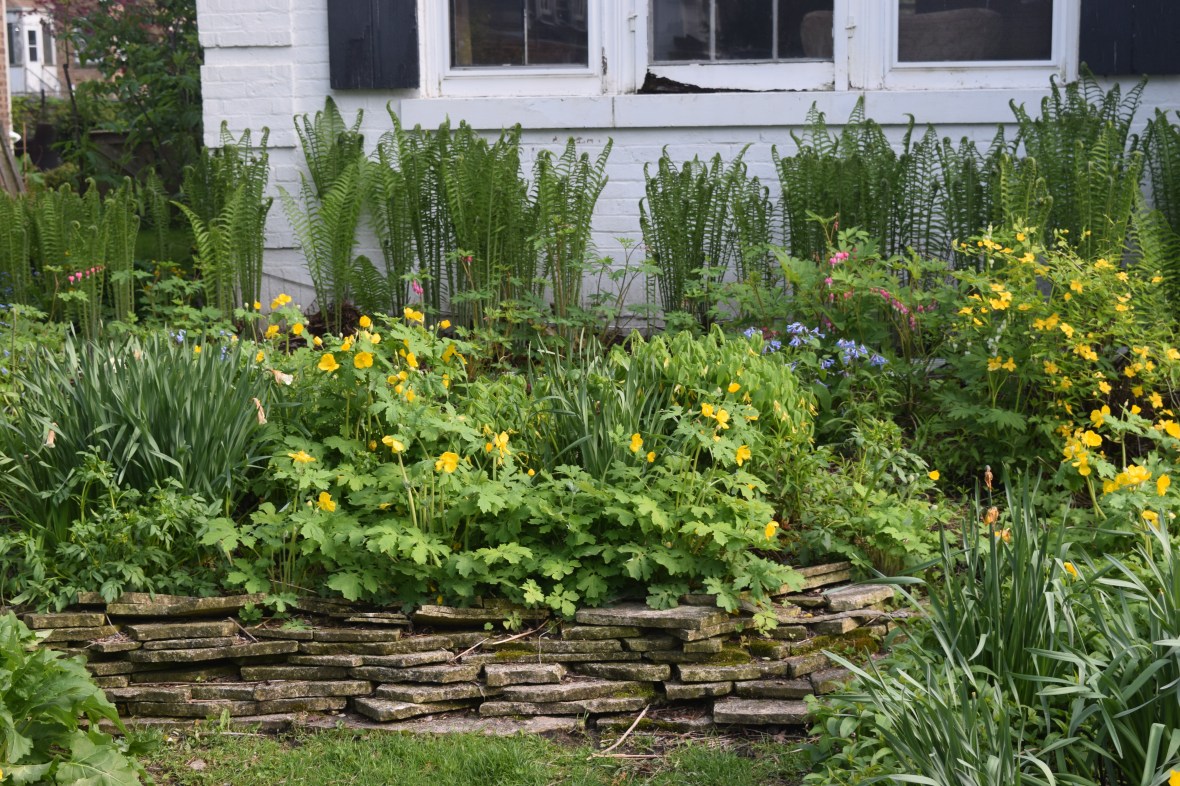
By the middle of the month they are more substantial.
A problem with Ostrich Ferns is that they will totally take over any space – if you let them, which is not what I intended. My goal has been to keep them behind the Bleeding Hearts (Lamprocapnos spectabilis). Digging the ferns out is a messy and rather strenuous job, so this year I’ve just been snapping off the unwanted fronds as they emerge.
Frond snapping is easier but requires considerable vigilance, as the Ostrich Ferns are not the type of plants to give up after a single try.

There’s a little path that starts here and lets me get into the area between the ferns and the perennials.
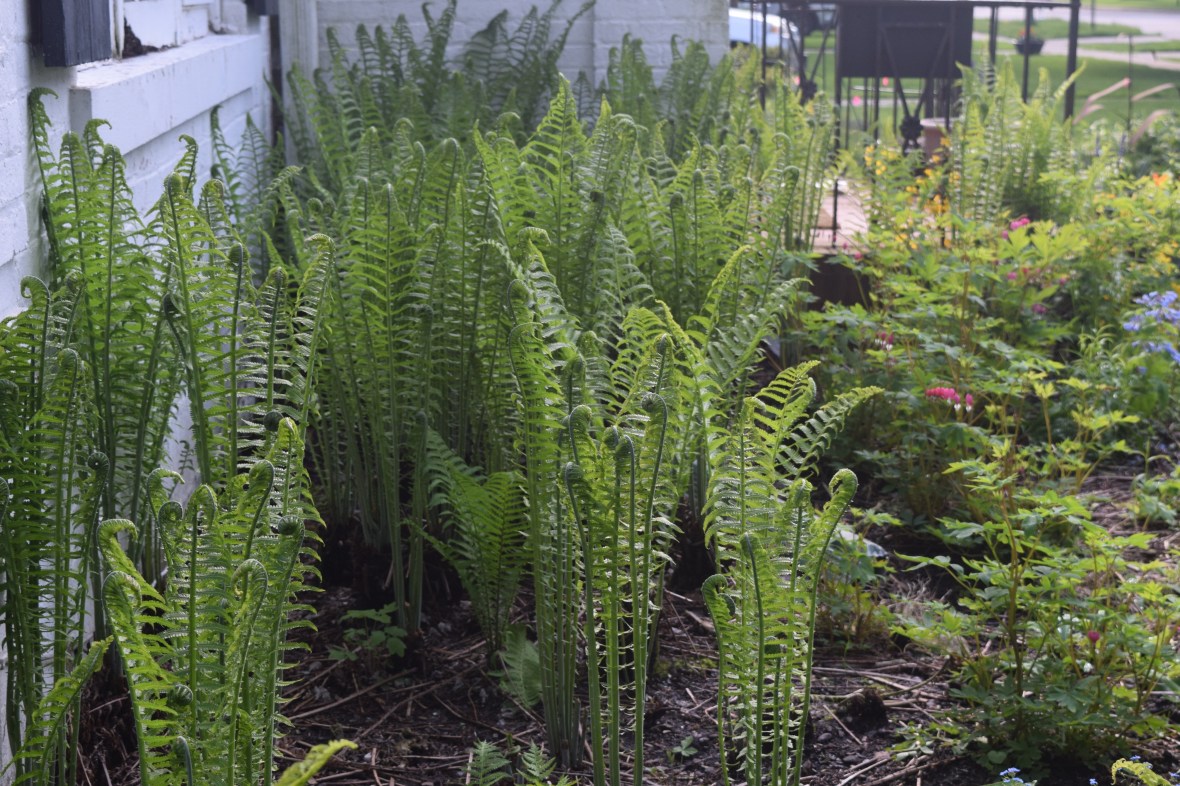
Side view of the Ostrich Ferns. By early summer they form a solid wall of green around 4′ high.

As you can see here in a summer photo that’s a couple of years old.
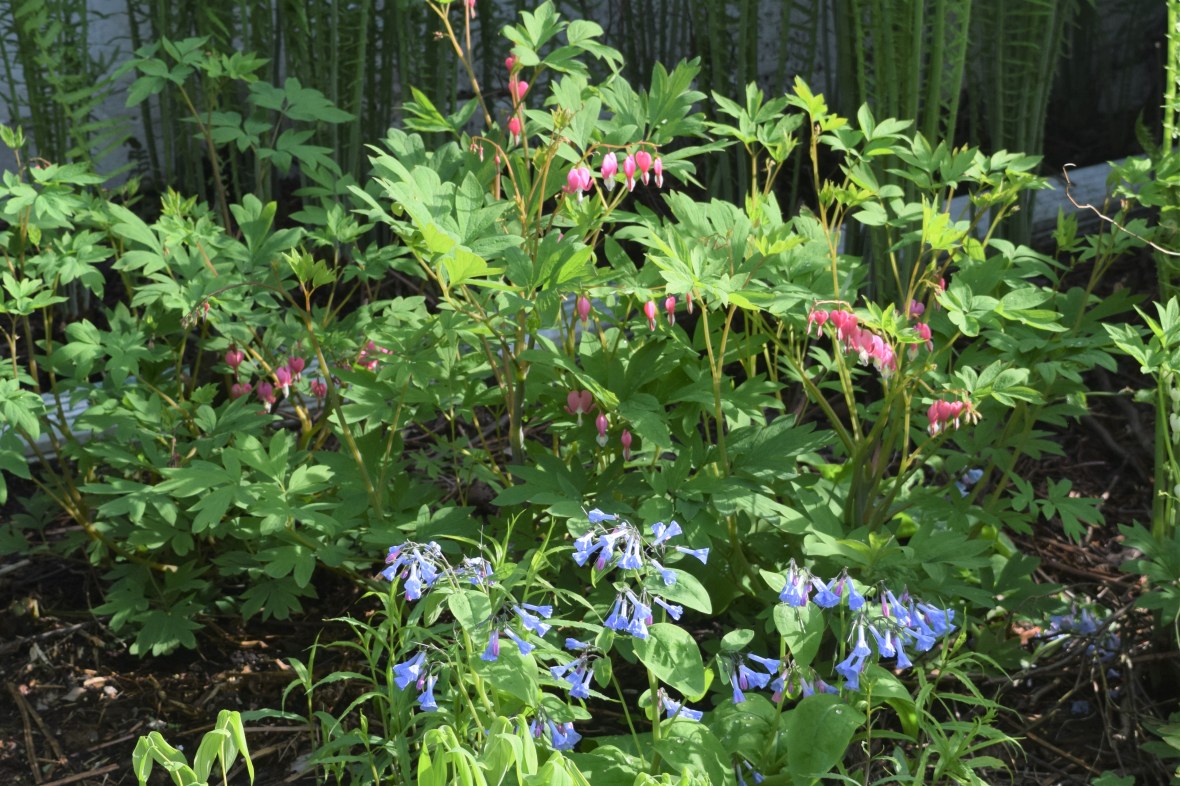
As for the rest of the planting, there are Virginia Bluebells (Mertensia virginica) to go with the Bleeding Hearts. A classic combo, though their timing is not always in sync. This year the Bluebells bloomed on time but the Bleeding Hearts are running late.

There’s also False Forget-Me-Not (Brunnera macrophylla).

The Brunnera mixes nicely with Celandine Poppy (Stylophorum diphyllum).

There are a couple of patches of Great Merrybells (Uvularia grandiflora). It makes a good groundcover after the flowers are done.
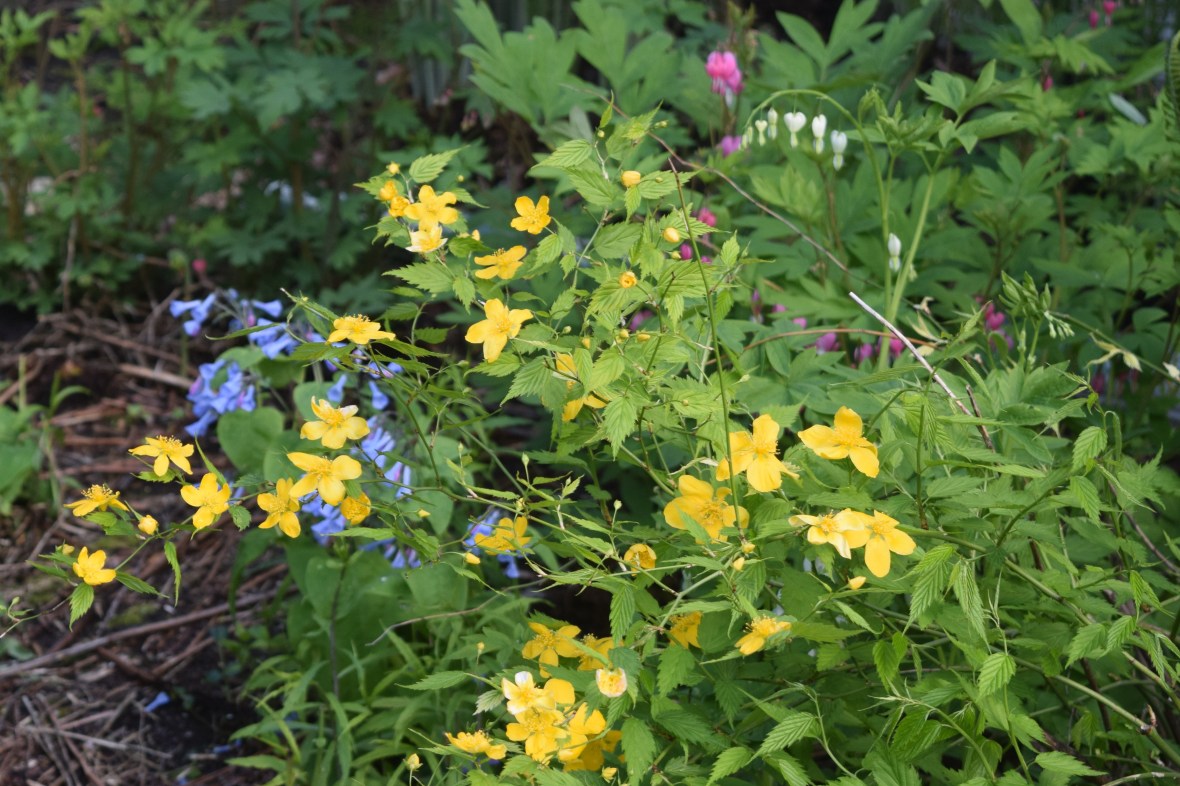
In one corner there’s this small shrub with yellow flowers inherited from the former owners. I’m guessing it’s Japanese Kerria (Kerria japonica).
In summer and fall other plants come forward to provide companionship to the Ostrich Ferns: Golden Alexander (Zizia aurea), Short’s Aster (Symphyotrichum shortii), Bluestem Goldenrod (Solidago caesia), among others.
Of course, the biggest problem with a foundation planting of Ostrich Ferns is that it tends to die away in early fall and provides little interest through winter. I’m thinking now I should interplant the Ostrich Ferns with Palm Sedge (Carex muskingumensis), which could stand through winter and prevent the wall from being completely bare. What do you think?

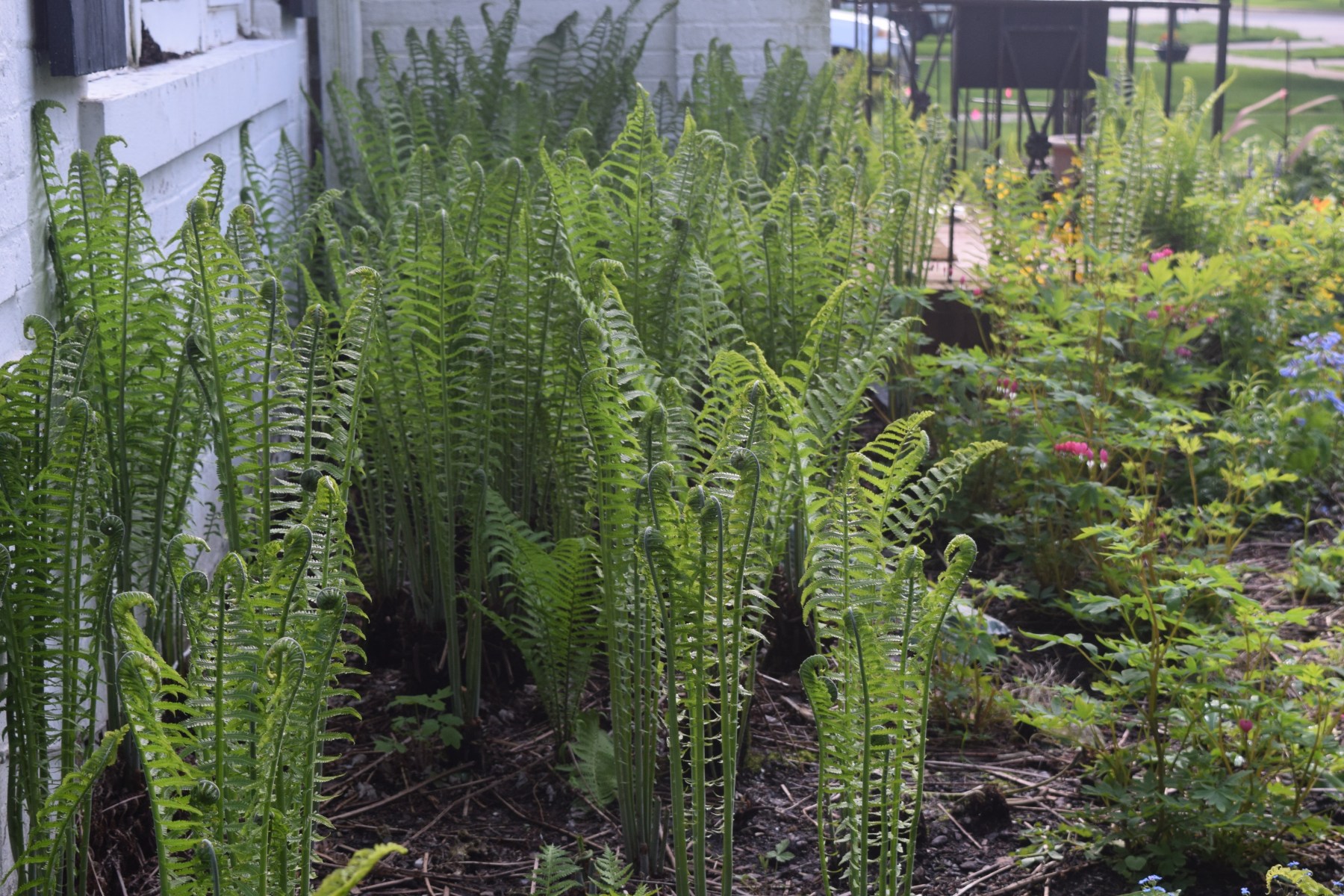




Go for it!
I just might!
Keep us posted!
I love to do the photos! Thanks for sharing. Greetings from London.
Greetings back to you from Chicago!
I had to look Palm Sedge up to see what it looks like. It’s okay. I guess it depends on whether you like how it looks up against the house during the winter months. Maybe something with a bit more color that would stand out more against the white?
I like the combination of the Bleeding Hearts and the Virginia Bluebells.
Good point — the Palm Sedge is sort of a straw color in winter, I guess not much of a contrast.
I do not know what to think. Foundation planting is not such a standard feature in California, probably because most of the homes here were built at a time when such plantings were not important, and so many more homes are lower to the ground. (Foundation plantings really should be more popular in this neighborhood where gutters are constantly clogged with debris from the redwoods, and it is so dangerous to clean gutters on eaves of homes that hang over deep canyons!) I think if I wanted foundation planting, I would not want something that is bare in winter, when it is most important. That would be my main gripe with ostrich fern. Otherwise, I think that the ostrich fern is very appealing, and would be very appealing even without help from its friends. I normally do not like shrubby plant material that gets higher than the widow sills, but for the ostrich ferns, only the tops of the fronds are above the windows, so there is no view of the backside of shrubbery from inside.
Bare winter walls is definitely a drawback. It’s just that I hate yew, which is so boring and requires regular pruning so that it won’t block the windows. I find the ferns much more appealing.
Gee, I was not aware that I was so boring.
I’d say you have very little in common with Yew.
I would not know, since I am not familiar with the common sort.
It’s a beautiful foundation plan, wow! Do you have enough sun (and room) for a couple red twig dogwoods for bulky structure and winter interest? Gary Ladman at Classic Viburnums recommended mapleleaf viburnums for me. I’ve got a shady/small/urban lot and a desire to provide for birds and pollinators.
This is the north side of the house so there is limited sun. I’ve tried to think of some kind of deciduous dwarf shrub to go with the ferns but so far have come up with no ideas. I really want something no taller than 4′, and not too dense.
Two dwarf shrubs to consider: 1.) ‘Scentlandia’ Sweetspire (a PW introduction last year that, so far, is perfectly happy – and smells perfectly wonderful – in almost full shade and moist/wet soil along the east side of our house; MD, 7a); 2.) ‘Arctic Fire’ Red Twig Dogwood (doing okay in slightly drier, filtered shade). Bushy St. John’s Wort (Hypericum densiflorum) might also work since you have some sun; you are northwest of its native range, but it is rated to Zone 5. Wish I could get my Ostrich Ferns to grow as tall as yours!
Thanks for these ideas! The St. John’s Wort sounds good, it is similar to the Kerria I think. I have tried Sweetspire but it doesn’t seem to like our alkaline soil. Is ‘Arctic Fire’ a compact variety? I don’t want anything too tall.
I second Amy in suggesting interspersing some dogwoods? Would give some winter interest and break up the (albeit beautiful) stretch of ferns. Good luck! Can’t wait to see updates!
They would have to be dwarf dogwoods – I don’t want anything over 4′. And they would have to tolerate a mostly shady space.
In my early gardening days, when most of all I planted were perennials, winter left me with a bare garden. Ever since I take special care to review my winter garden and plant enough evergreens to keep my spirit up. Ostrich Ferns are gorgeous when at their peak, and Sedge is a fine choice to support the foundation. The hard part will be keep the ferns in check.
I hear you. I just can’t think of an evergreen that works for this space. I love the evergreen hedge at Lurie Garden and how it provides a background for all the colorful flowers.
The palm sedges are nice, but when I looked at the photos of them in winter, I thought I’d like a touch more color (although photos always are hard to judge, of course). I wondered about little bluestem. Our native holds its color all winter, and it seems there are some varieties that have been developed that are gorgeous. There might even be other ornamental grasses that would do. Of course, how they’d fit with the ferns is something I don’t know.
My experience is that bluestem needs more sun and better drainage than this part of the garden gets, particularly if it’s planted for winter color.
Agreed. For me it needs really full sun to do well.
I think this spot is much too shady for Little Bluestem. It is a beautiful grass, though.
Those Ostrich ferns are gorgeous but they can be a bit rampant. I love them and my DB hates them because of the way they roam. I don’t mind that. I think they are easily dug up especially if you get them young. They can be persistent though. I think your idea of a sedge that could compete for turf would be fine and the contrast of the textures would be good. Sedges have edges. I read that these could be sharp.
They are persistent. Controlling them will be a never-ending chore.
I adore ostrich ferns. I wish mine were as vigorous as yours. They look gorgeous. I like carex grayii. I don’t know how it looks in your area in winter but it is nice here in Georgia in winter months. https://plants.usda.gov/core/profile?symbol=CAGR5
Is grayii the one with what looks like little medieval maces?
Yes, that’s it.
Cool. I’ve always wanted a big fern stand, they’re so lovely when they come awake in the spring.
Yes, they are! Such a fresh green, like they would be delicious in salad.
Wow – those ferns look really happy! Needless to say, love those spring blooming native plants too.
Ferns seem to like it in our garden … maybe a little too much.
That last photo is of a Japanese kerria with single rather than double flowers. My favorite.
If you go to a restaurant (someday) and order a dish of those fiddleheads you’ve been snapping off the ostrich ferns you’ll pay a hefty price.
You know, we tried cooking fiddleheads, and I wasn’t really impressed.
I’ve heard they’re supposed to taste like asparagus but I’ve never had them.
Oh, your new inter planting sounds interesting. I love your ferns, we inherited ferns, which are utterly indestructible. I see them similar to mares tail, I just snap them off.xxx
And keep snapping them off when they come back!
Your ferns looks so unbelievably green and lush to me, and I can hardly imagine having so much choice in what you decide to grow..it is all looking wonderful from an Aussie point of view!
But then you have all those fantastically-colored birds. And just a little bit of snow.
True!
It‘s lovely to see all that fresh fern foliage and the old favourites together like Bleeding Hearts and Bluebells. (I see you can now rattle off the new name for Bleeding Heart without batting an eyelid! 😉 ) I am a great fan of all Carex, so I would say give it a go.
I will use the new name for Bleeding Hearts, but I won’t like it.
I know the new name, but am continuing to be rebellious and thus still call them dicentra, LOL.
Palm sedge is the only sedge I have that is as almost as bad a runner as ostrich fern. I would rethink that choice.
OK. Duly noted.
I’m amazed at how similar some of our blog posts are. I filmed ferns and added ominous music to my YouTube video of them because they’re steadily invading. I just posted about a cardinal nest in honeysuckle vine and an unwanted chipmunk visitor! 🙂
We’re gardening in similar places, I guess.
The green backdrop really plays well with all the colors in front of it. About ferns I know nothing. But I can admire them.
I agree about the green backdrop. If only it lasted longer.
Hello Jason, eight years after moving into the current garden and while I have rampant Carex Pendula (another type of sedge grass) under control, it’s still in patches in the grass and its seeds occasionally germinate when the soil is disturbed (still after 8 years). I would only touch sedge with napalm. Palm sedge might be different, but I’ve blacklisted the whole genus on principal.
There are some sedges that are well-behaved, but Palm Sedge may not be one of those.
HI, I would recommend azaleas, specifically:
‘Karen’ is a dense, upright, compact, evergreen azalea that grows to 3-4′ tall and as wide. It is noted for having excellent winter hardiness.
Since the shrub will be protected right in front of your home, I think they will be fine, plus the shrub should hold its foliage thru out the winter.